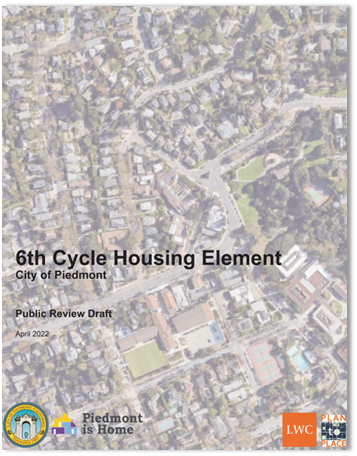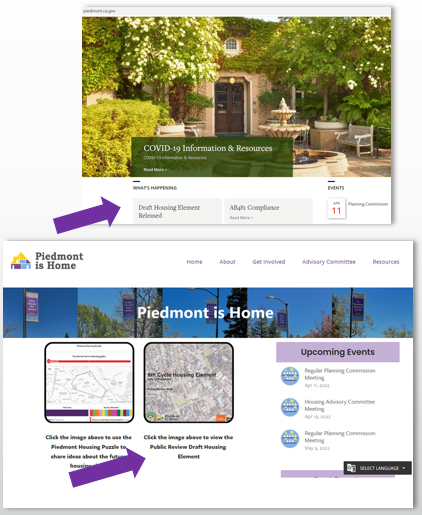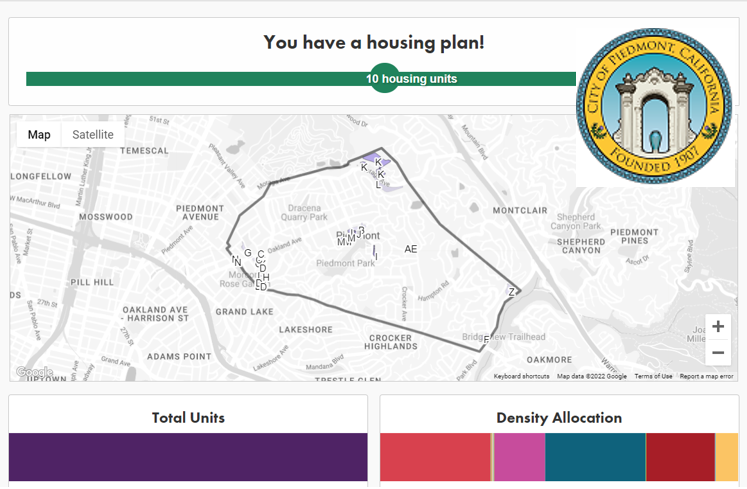Apr 2 2022
On Monday, April 4, City Council will be voting on whether the energy system for the new Aquatic Center will be all-electric or continue to rely on natural gas (a fossil fuel) for heating pool water, as in the past. Here are some frequently asked questions about an all-electric pool system, with answers drawn from information presented at the March 21st Council meeting by the City’s Sustainability Program Manager, as well as ELS Architecture and their energy engineer.
Q: What are Piedmont’s greenhouse gas (GHG) emissions reduction targets?
A: Our current targets, as outlined in our 2018 Climate Action Plan 2.0 (CAP 2.0), were in line with State targets at that time – that is, to reduce our in-boundary emissions to 40% below 2005 levels by 2030 and to 8% below 2005 levels by 2050. But State goals have become stronger since then. California now targets achieving 100% emissions-free electricity and carbon neutrality by 2045.
Q: How close is Piedmont to achieving the GHG emissions reduction goals we set in 2018?
A: Piedmont has made incremental improvements over time but has far to go to meet our CAP 2.0 goals. The majority of our reductions so far can be attributed to forces outside Piedmont, such as increased home appliance efficiency. Since the majority of Piedmont’s emissions come from the residential sector, we can only meet our reduction targets if all residents make a concerted effort to decarbonize both their homes and their transportation. Unfortunately, rather than declining, our use of natural gas, the main source of GHG emissions from Piedmont buildings (municipal, residential, and commercial), has risen by 14% since 2014.
Q: What role must the City play in encouraging residents to decarbonize their homes and transportation?
A: The CAP 2.0 emphasizes that the City must focus on educating residents about emissions reduction opportunities and lead by example. Even though City emissions are only 2-4% of total Piedmont emissions, reducing these emissions will play an outsize role in Piedmont’s success in reducing its emissions overall, due to the demonstration effect the City’s efforts will have in motivating residents to decarbonize their own homes and transportation. Specific municipal or City goals in the CAP 2.0 include committing to Piedmont’s municipal facilities and activities becoming Zero-Carbon by 2050, about 25 years after the opening of the new pool facility.
Q: Will the City be able to meet its municipal carbon emissions reduction targets (as outlined in the CAP 2.0) if pool water in the new Aquatic Facility is heated by natural gas, a fossil fuel?
A: No. Heating the old pool with natural gas generated ~87% of the GHG emissions from municipal buildings and structures. If the new facility, with its increased pool square footage and water volume, were heated with natural gas, it would generate between 55-76% more emissions than the old pool (depending on whether or not some solar is installed). The City would not be able to make up for this increase in emissions by cutting emissions from other sources. In contrast, GHG emissions from operating an all-electric facility that relies on a combination of photovoltaic and thermal solar, electric heat pumps, and green grid electricity would be zero. The City would entirely eliminate the GHG emissions generated by the old facility, achieving a very significant municipal GHG emissions reduction.
Q: Using electric heat pumps to heat commercial-sized pools is a new application of this technology in California, so how can we be certain it will work?
A: ELS Architecture and the engineering firm they are working with are fully confident that electric heat pump technology will work for the new Piedmont Aquatic Center. They have designed an all-electric pool for Mountain View which will soon go out to bid. The reason an all-electric municipal pool seems innovative is that aquatic facilities comprise less than 3% of new public construction statewide. Looking at the public building sector overall, from State and municipal buildings to buildings in the public education systems, new all-electric facilities are being constructed everywhere, and old buildings are undergoing significant retrofits to become all-electric. We are in the midst of an all-electric movement within both the public and private building sectors. Electric heat pump technology has been around for a long time, and, in states like Florida that are not piped for natural gas, 90% of commercial pools are heated by electric heat pumps. The reason this hasn’t been the case here in the West has been the cheap price of natural gas, a situation that is fast ending.
Q: How do the costs of an all-electric vs. a gas-powered system compare?
A: The upfront costs of an all-electric system will be higher by at least $600,000 (a more exact figure, based on recent facility design changes is forthcoming), but a lifecycle analysis shows that an all-electric facility will result in approximately $1,000,000 more in cost savings over 25 years, as compared to a system that uses natural gas. For more information, see the March 21 Staff Report on ELS’s Energy Use Report.
Q: Might the noise of the heat pumps be problematic for pool and tennis court users, as well as nearby residents?
A: This will not be a complicated issue to resolve, as solutions are routinely found for much more complex noise issues. ELS will work with an acoustician on measures to dampen any undesirable sound from the array of heat pumps. Most of this work will take place after all the pool equipment is in place and functioning, but some pre-work may be done (for example, insulating certain walls and suspending a roof over the equipment). Since we’ll have an array of heat pumps, it will be rare for them all to be working at their top (i.e. noisiest) capacity – for example, when the temperature gets below 30 degrees F. In addition, the heat pumps we’re looking at have a low decibel nighttime rating.
Q: Will relying on the clean electricity grid be more expensive than natural gas over the next 20 years?
A: The era of cheap natural gas is ending. Already, natural gas prices have gone up 200% since 2018, and every indication is that they will continue to rise. PG&E is proposing a 40% increase in natural gas prices over the next four years, as they add transportation and distribution costs for natural gas that aren’t on our current bills. In addition, the California Public Utilities Commission is moving cost rates for natural gas infrastructure solely onto the developer (vs. sharing with rate payers). Moreover, within the next 5-10 years we’ll be seeing carbon pricing or carbon taxes adding to the cost of natural gas.
Q. Will the electricity grid be able to reliably supply us with the clean electricity an all-electric Aquatic Facility will need?
A: Yes. While upgrading California’s electricity transmission systems to accommodate the level of clean electricity the state aims to generate by 2045 is undoubtedly a challenge, there is no reason to worry that there won’t be enough electricity available. Our local clean electricity provider, East Bay Community Energy (EBCE), is supporting various projects to generate clean electricity locally and is continuously increasing the percentage of electricity from renewable sources in its power mix. Thanks to a 2018 City Council decision, the City is enrolled in EBCEs Renewable 100 plan, whereby the electricity EBCE purchases on our behalf comes only from renewable sources (wind, solar, and small-scale hydroelectric). Approximately 95% of Piedmont residents are also enrolled in Renewable 100.
Q: Isn’t it risky to rely on electricity during Planned Power Outages during fire season?
A: There’s no advantage to having a natural gas system to heat pool water during a power outage, since all natural gas boilers sold in California have electric power starts. They no longer have standing pilots that allow you to have gas service during an electric outage. The pumping system for keeping water circulating is the same between a natural gas and an all-electric system, so natural gas has no advantage here either. Currently, battery storage technology to use for emergency backup is not available, but advances are being made in solar battery storage.
Q: Could we start with a natural gas heated pool and pivot to an all-electric system later?
A: It would be hard and prohibitively expensive to retrofit for electricity later. Even if we included the pre-conduits and other infrastructure for electrification in a system that initially relied on natural gas, this would also push up costs. In either case, we would be paying for the cost of two different energy systems and abandoning the natural gas system before the end of the pool’s lifetime.
Q: Was the concept and cost of an all-electric facility factored into Measure UU?
A: No. When the conceptual master plan was initially developed in 2016, all-electric pool heating was not considered, and the baseline assumption was for natural gas, although some “green features” were proposed (solar and thermal tubes). But the details of the energy system were not specified, in the same way that most of the other details being fleshed out now (pool size, building and public space design, etc.) were not. Similarly, the 2016 conceptual plan did not do a GHG emissions analysis or consider how this municipal construction project would comply with Piedmont’s 2010 Climate Action Plan then in place. Since 2016, not only was Piedmont’s 2018 CAP 2.0 adopted, but the transition off natural gas and towards full electrification of public and private buildings and facilities across the state began in earnest, and other municipalities began to consider or actually design all-electric pools. After the passage of UU, Piedmont Connect and residents focused on how to reduce the carbon footprint of the new pool complex. Connect researched and modeled the possibility of designing an all-electric facility that would emit zero GHG emissions in its operation and help the City meet its CAP 2.0 goals. Connect’s calculations showed that it would be both economically and technologically feasible, the same conclusion that the project architects and engineers have now drawn. (A report Connect prepared in 2021 can be viewed here.) City staff and Council have made public commitments several times to support the “greenest” pool possible. When hired, ELS was directed by the City to conduct an energy analysis of the pool, and it stated publicly that it would design for an all-electric option. Since the City chose to wait until the design phase of the project to conduct this energy feasibility assessment and to decide on the facility’s energy system, it may appear that an all-electric facility is an afterthought. But, in reality, this discussion has been going on for some time.
Submitted by Margaret Ovenden, Piedmont Resident
Agenda and Participation Information HERE.
Staff Report HERE









